[English] 日本語
 Yorodumi
Yorodumi- PDB-1xr0: Structural Basis of SNT PTB Domain Interactions with Distinct Neu... -
+ Open data
Open data
- Basic information
Basic information
| Entry | Database: PDB / ID: 1xr0 | ||||||
|---|---|---|---|---|---|---|---|
| Title | Structural Basis of SNT PTB Domain Interactions with Distinct Neurotrophic Receptors | ||||||
 Components Components |
| ||||||
 Keywords Keywords |  SIGNALING PROTEIN/GROWTH FACTOR RECEPTOR / SIGNALING PROTEIN/GROWTH FACTOR RECEPTOR /  FGFR / SNT / phosphotyrosine binding domain / PTB / TRK / NPXpY motif / FGFR / SNT / phosphotyrosine binding domain / PTB / TRK / NPXpY motif /  SIGNALING PROTEIN-GROWTH FACTOR RECEPTOR COMPLEX SIGNALING PROTEIN-GROWTH FACTOR RECEPTOR COMPLEX | ||||||
| Function / homology |  Function and homology information Function and homology informationlens placode formation involved in camera-type eye formation /  cell surface receptor protein tyrosine phosphatase signaling pathway / negative regulation of cardiac muscle cell differentiation / lens fiber cell development / Signaling by FGFR1 amplification mutants / negative regulation of fibroblast growth factor production / positive regulation of mitotic cell cycle DNA replication / regulation of extrinsic apoptotic signaling pathway in absence of ligand / Signaling by plasma membrane FGFR1 fusions / diphosphate metabolic process ...lens placode formation involved in camera-type eye formation / cell surface receptor protein tyrosine phosphatase signaling pathway / negative regulation of cardiac muscle cell differentiation / lens fiber cell development / Signaling by FGFR1 amplification mutants / negative regulation of fibroblast growth factor production / positive regulation of mitotic cell cycle DNA replication / regulation of extrinsic apoptotic signaling pathway in absence of ligand / Signaling by plasma membrane FGFR1 fusions / diphosphate metabolic process ...lens placode formation involved in camera-type eye formation /  cell surface receptor protein tyrosine phosphatase signaling pathway / negative regulation of cardiac muscle cell differentiation / lens fiber cell development / Signaling by FGFR1 amplification mutants / negative regulation of fibroblast growth factor production / positive regulation of mitotic cell cycle DNA replication / regulation of extrinsic apoptotic signaling pathway in absence of ligand / Signaling by plasma membrane FGFR1 fusions / diphosphate metabolic process / FGFR1c and Klotho ligand binding and activation / vitamin D3 metabolic process / regulation of phosphate transport / regulation of lateral mesodermal cell fate specification / anterior/posterior axis specification, embryo / positive regulation of MAPKKK cascade by fibroblast growth factor receptor signaling pathway / cementum mineralization / positive regulation of endothelial cell chemotaxis to fibroblast growth factor / receptor-receptor interaction / response to sodium phosphate / regulation of branching involved in salivary gland morphogenesis by mesenchymal-epithelial signaling / fibroblast growth factor receptor signaling pathway involved in orbitofrontal cortex development / auditory receptor cell development / ventricular zone neuroblast division / Epithelial-Mesenchymal Transition (EMT) during gastrulation / positive regulation of parathyroid hormone secretion / chordate embryonic development / mesenchymal cell proliferation / phosphatase activator activity / paraxial mesoderm development / cell surface receptor protein tyrosine phosphatase signaling pathway / negative regulation of cardiac muscle cell differentiation / lens fiber cell development / Signaling by FGFR1 amplification mutants / negative regulation of fibroblast growth factor production / positive regulation of mitotic cell cycle DNA replication / regulation of extrinsic apoptotic signaling pathway in absence of ligand / Signaling by plasma membrane FGFR1 fusions / diphosphate metabolic process / FGFR1c and Klotho ligand binding and activation / vitamin D3 metabolic process / regulation of phosphate transport / regulation of lateral mesodermal cell fate specification / anterior/posterior axis specification, embryo / positive regulation of MAPKKK cascade by fibroblast growth factor receptor signaling pathway / cementum mineralization / positive regulation of endothelial cell chemotaxis to fibroblast growth factor / receptor-receptor interaction / response to sodium phosphate / regulation of branching involved in salivary gland morphogenesis by mesenchymal-epithelial signaling / fibroblast growth factor receptor signaling pathway involved in orbitofrontal cortex development / auditory receptor cell development / ventricular zone neuroblast division / Epithelial-Mesenchymal Transition (EMT) during gastrulation / positive regulation of parathyroid hormone secretion / chordate embryonic development / mesenchymal cell proliferation / phosphatase activator activity / paraxial mesoderm development /  fibroblast growth factor receptor binding / fibroblast growth factor receptor binding /  fibroblast growth factor receptor activity / FGFR1b ligand binding and activation / branching involved in salivary gland morphogenesis / Signaling by activated point mutants of FGFR1 / FGFR1c ligand binding and activation / organ induction / Downstream signaling of activated FGFR1 / Phospholipase C-mediated cascade: FGFR1 / positive regulation of phospholipase activity / neurotrophin TRKA receptor binding / lung-associated mesenchyme development / cell projection assembly / regulation of epithelial cell proliferation / fibroblast growth factor receptor activity / FGFR1b ligand binding and activation / branching involved in salivary gland morphogenesis / Signaling by activated point mutants of FGFR1 / FGFR1c ligand binding and activation / organ induction / Downstream signaling of activated FGFR1 / Phospholipase C-mediated cascade: FGFR1 / positive regulation of phospholipase activity / neurotrophin TRKA receptor binding / lung-associated mesenchyme development / cell projection assembly / regulation of epithelial cell proliferation /  transmembrane receptor protein tyrosine kinase adaptor activity / gastrulation with mouth forming second / phosphatidylinositol-mediated signaling / outer ear morphogenesis / middle ear morphogenesis / embryonic limb morphogenesis / transmembrane receptor protein tyrosine kinase adaptor activity / gastrulation with mouth forming second / phosphatidylinositol-mediated signaling / outer ear morphogenesis / middle ear morphogenesis / embryonic limb morphogenesis /  skeletal system morphogenesis / RND1 GTPase cycle / ureteric bud development / RND2 GTPase cycle / positive regulation of vascular endothelial cell proliferation / positive regulation of mesenchymal cell proliferation / cardiac muscle cell proliferation / ventricular septum development / inner ear morphogenesis / midbrain development / Signaling by ALK / Frs2-mediated activation / PI-3K cascade:FGFR3 / skeletal system morphogenesis / RND1 GTPase cycle / ureteric bud development / RND2 GTPase cycle / positive regulation of vascular endothelial cell proliferation / positive regulation of mesenchymal cell proliferation / cardiac muscle cell proliferation / ventricular septum development / inner ear morphogenesis / midbrain development / Signaling by ALK / Frs2-mediated activation / PI-3K cascade:FGFR3 /  fibroblast growth factor binding / prostate epithelial cord arborization involved in prostate glandular acinus morphogenesis / positive regulation of stem cell proliferation / PI-3K cascade:FGFR2 / Formation of paraxial mesoderm / PI-3K cascade:FGFR4 / fibroblast growth factor binding / prostate epithelial cord arborization involved in prostate glandular acinus morphogenesis / positive regulation of stem cell proliferation / PI-3K cascade:FGFR2 / Formation of paraxial mesoderm / PI-3K cascade:FGFR4 /  regulation of cell differentiation / PI-3K cascade:FGFR1 / neuroblast proliferation / Signaling by ALK fusions and activated point mutants / RET signaling / PI3K Cascade / regulation of cell differentiation / PI-3K cascade:FGFR1 / neuroblast proliferation / Signaling by ALK fusions and activated point mutants / RET signaling / PI3K Cascade /  epithelial to mesenchymal transition / positive regulation of blood vessel endothelial cell migration / epithelial to mesenchymal transition / positive regulation of blood vessel endothelial cell migration /  endomembrane system / fibroblast growth factor receptor signaling pathway / calcium ion homeostasis / Activated NTRK2 signals through FRS2 and FRS3 / chondrocyte differentiation / positive regulation of phospholipase C activity / Signaling by FGFR4 in disease / SHC-mediated cascade:FGFR1 / forebrain development / FRS-mediated FGFR3 signaling / cell maturation / FRS-mediated FGFR2 signaling / positive regulation of cardiac muscle cell proliferation / FRS-mediated FGFR4 signaling / Signaling by FGFR3 in disease / FRS-mediated FGFR1 signaling / positive regulation of vascular associated smooth muscle cell proliferation / Signaling by FGFR2 in disease / positive regulation of neuron differentiation / Signaling by FGFR1 in disease / endomembrane system / fibroblast growth factor receptor signaling pathway / calcium ion homeostasis / Activated NTRK2 signals through FRS2 and FRS3 / chondrocyte differentiation / positive regulation of phospholipase C activity / Signaling by FGFR4 in disease / SHC-mediated cascade:FGFR1 / forebrain development / FRS-mediated FGFR3 signaling / cell maturation / FRS-mediated FGFR2 signaling / positive regulation of cardiac muscle cell proliferation / FRS-mediated FGFR4 signaling / Signaling by FGFR3 in disease / FRS-mediated FGFR1 signaling / positive regulation of vascular associated smooth muscle cell proliferation / Signaling by FGFR2 in disease / positive regulation of neuron differentiation / Signaling by FGFR1 in disease /  SH2 domain binding / NCAM signaling for neurite out-growth / regulation of ERK1 and ERK2 cascade SH2 domain binding / NCAM signaling for neurite out-growth / regulation of ERK1 and ERK2 cascadeSimilarity search - Function | ||||||
| Biological species |   Homo sapiens (human) Homo sapiens (human) | ||||||
| Method |  SOLUTION NMR / Structures of the SNT-1 PTB domain in complex with the hFGFR1 peptide were calculated with a distance geometry, simulated annealing protocol by using the X-PLOR program ([4]). NOE distance, dihedral angle restraints were treated with a square-well potential of 50 kcal mol?1 ?2. A total of 2448 manually assigned NOE-derived distance restraints were obtained from the 15N- or 13C-edited NOESY data. Included in this figure are 251 intrapeptide, 258 intermolecular distance restraints. Additionally, 255 unambiguous, 52 ambiguous distance restraints were identified from the NOE data by using ARIA. The final structure calculations employed a total of 2755 NOE restraints obtained from the manual, the ARIA-assisted assignments, 2703 of which were unambiguously assigned NOE-derived distance restraints that comprise 1072 intraresidue, 466 sequential, 216 medium-range, and 949 long-range NOEs. In addition, 70 hydrogen-bond distance restraints for 35 hydrogen bonds, 19 -angle restraints were also used in the structure calculations. For the ensemble of the final 20 structures, no distance or torsional angle restraint was violated by more than 0.4 or 5, respectively. The distance-violation, dihedral-violation, and total energies were 74.4 1.7 kcal mol, 1, 0.82 0.08 kcal mol, 1, and 262.0 6.0 kcal mol, 1, respectively. The Lennard-Jones potential, which was not used during any refinement stage, was 659.3 23.1 kcal mol, 1 for the final structures. Ramachandran plot analysis by Procheck-NMR showed that in the final structures of the complex, 98.1% of the backbone geometries of the non-Gly, non-Pro residues in the complex (protein residues 18-116, peptide residues (412-430), nearly 100% in the secondary structure (protein residues 19-24, 35-40, 45-49, 52-57, 63-68, 71-76, 85-90, 94-107, and 111-115, peptide residues 426-430) lie within energetically favorable or allowed regions. SOLUTION NMR / Structures of the SNT-1 PTB domain in complex with the hFGFR1 peptide were calculated with a distance geometry, simulated annealing protocol by using the X-PLOR program ([4]). NOE distance, dihedral angle restraints were treated with a square-well potential of 50 kcal mol?1 ?2. A total of 2448 manually assigned NOE-derived distance restraints were obtained from the 15N- or 13C-edited NOESY data. Included in this figure are 251 intrapeptide, 258 intermolecular distance restraints. Additionally, 255 unambiguous, 52 ambiguous distance restraints were identified from the NOE data by using ARIA. The final structure calculations employed a total of 2755 NOE restraints obtained from the manual, the ARIA-assisted assignments, 2703 of which were unambiguously assigned NOE-derived distance restraints that comprise 1072 intraresidue, 466 sequential, 216 medium-range, and 949 long-range NOEs. In addition, 70 hydrogen-bond distance restraints for 35 hydrogen bonds, 19 -angle restraints were also used in the structure calculations. For the ensemble of the final 20 structures, no distance or torsional angle restraint was violated by more than 0.4 or 5, respectively. The distance-violation, dihedral-violation, and total energies were 74.4 1.7 kcal mol, 1, 0.82 0.08 kcal mol, 1, and 262.0 6.0 kcal mol, 1, respectively. The Lennard-Jones potential, which was not used during any refinement stage, was 659.3 23.1 kcal mol, 1 for the final structures. Ramachandran plot analysis by Procheck-NMR showed that in the final structures of the complex, 98.1% of the backbone geometries of the non-Gly, non-Pro residues in the complex (protein residues 18-116, peptide residues (412-430), nearly 100% in the secondary structure (protein residues 19-24, 35-40, 45-49, 52-57, 63-68, 71-76, 85-90, 94-107, and 111-115, peptide residues 426-430) lie within energetically favorable or allowed regions. | ||||||
 Authors Authors | Dhalluin, C. / Yan, K.S. / Plotnikova, O. / Lee, K.W. / Zeng, L. / Kuti, M. / Mujtaba, S. / Goldfarb, M.P. / Zhou, M.-M. | ||||||
 Citation Citation |  Journal: Mol.Cell / Year: 2000 Journal: Mol.Cell / Year: 2000Title: Structural Basis of SNT PTB Domain Interactions with Distinct Neurotrophic Receptors Authors: Dhalluin, C. / Yan, K.S. / Plotnikova, O. / Lee, K.W. / Zeng, L. / Kuti, M. / Mujtaba, S. / Goldfarb, M.P. / Zhou, M.-M. | ||||||
| History |
|
- Structure visualization
Structure visualization
| Structure viewer | Molecule:  Molmil Molmil Jmol/JSmol Jmol/JSmol |
|---|
- Downloads & links
Downloads & links
- Download
Download
| PDBx/mmCIF format |  1xr0.cif.gz 1xr0.cif.gz | 57.3 KB | Display |  PDBx/mmCIF format PDBx/mmCIF format |
|---|---|---|---|---|
| PDB format |  pdb1xr0.ent.gz pdb1xr0.ent.gz | 45.7 KB | Display |  PDB format PDB format |
| PDBx/mmJSON format |  1xr0.json.gz 1xr0.json.gz | Tree view |  PDBx/mmJSON format PDBx/mmJSON format | |
| Others |  Other downloads Other downloads |
-Validation report
| Arichive directory |  https://data.pdbj.org/pub/pdb/validation_reports/xr/1xr0 https://data.pdbj.org/pub/pdb/validation_reports/xr/1xr0 ftp://data.pdbj.org/pub/pdb/validation_reports/xr/1xr0 ftp://data.pdbj.org/pub/pdb/validation_reports/xr/1xr0 | HTTPS FTP |
|---|
-Related structure data
| Similar structure data |
|---|
- Links
Links
- Assembly
Assembly
| Deposited unit | 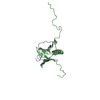
| |||||||||
|---|---|---|---|---|---|---|---|---|---|---|
| 1 |
| |||||||||
| NMR ensembles |
|
- Components
Components
| #1: Protein/peptide | Mass: 2492.983 Da / Num. of mol.: 1 Fragment: Sequence database residues 409-430 from the juxtamembrane region of hFGFR1 Source method: obtained synthetically Details: The peptide was chemically synthesized. The sequence is taken from Homo sapiens (human). References: UniProt: P11362 |
|---|---|
| #2: Protein | Mass: 15005.791 Da / Num. of mol.: 1 / Fragment: PTB domain at the N terminus Source method: isolated from a genetically manipulated source Source: (gene. exp.)   Homo sapiens (human) / Production host: Homo sapiens (human) / Production host:   Escherichia coli (E. coli) / References: UniProt: Q8WU20 Escherichia coli (E. coli) / References: UniProt: Q8WU20 |
-Experimental details
-Experiment
| Experiment | Method:  SOLUTION NMR SOLUTION NMR | ||||||||||||||||||||
|---|---|---|---|---|---|---|---|---|---|---|---|---|---|---|---|---|---|---|---|---|---|
| NMR experiment |
| ||||||||||||||||||||
| NMR details | Text: NMR spectra were acquired at 30C on a Bruker DRX600 or DRX500 spectrometer. The backbone and side chain 1H, 13C, and 15N resonances of the protein were assigned using deuterium-decoupled triple- ...Text: NMR spectra were acquired at 30C on a Bruker DRX600 or DRX500 spectrometer. The backbone and side chain 1H, 13C, and 15N resonances of the protein were assigned using deuterium-decoupled triple-resonance experiments of HNCA, HN(CO)CA, HNCACB, HN(CO)CACB, and (H)C(CO)NH-TOCSY ([34 and 30]) recorded by using uniformly 15N/13C-labeled and fractionally deuterated protein in complex with a nonisotopically labeled hFGFR1 peptide. The side chain assignments were completed using 3D HCCH-TOCSY ([7]) data collected from a uniformly 15N/13C labeled-protein/nonlabeled-peptide complex. NOE-derived distance restraints were obtained from 15N- or 13C-edited 3D NOESY spectra ([7]). -angle restraints were determined from 3JHN,H coupling constants measured in a 3D HNHA-J spectrum ([7]). Slowly exchanging amide protons were identified from a series of 2D 15N-HSQC spectra recorded after the H2O buffer was changed to 2H2O buffer. The peptide resonances were assigned using 13C/15N-filtered 2D NOESY and TOCSY spectra ([30]) collected from a 15N/13C labeled-protein/nonlabeled-peptide complex. The intermolecular NOEs used in defining the structure of the SNT-1 PTB domain/hFGFR1 complex were detected in 13C- or 15N-edited (F 1), 13C/15N-filtered (F 3) 3D NOESY spectra. All NMR spectra were processed with NMRPipe/NMRDraw ([8]) and analyzed using NMRView. |
- Sample preparation
Sample preparation
| Details | Contents: SNT-1 PTB domain/hFGFR1 peptide complex (1:1) of ~0.5 mM in 100 mM phosphate buffer of pH 6.5, 5 mM DTT-d10, and 0.5 mM EDTA in H2O/2H2O (9/1) or 2H2O Solvent system: H2O/2H2O (9/1) or 100% 2H2O |
|---|---|
| Sample conditions | Ionic strength: 15 mM DTT-d10, and 0.5 mM EDTA00 mM phosphate buffer, pH: 6.5 / Pressure: 1 atm / Temperature: 303 K |
-NMR measurement
| Radiation | Protocol: SINGLE WAVELENGTH / Monochromatic (M) / Laue (L): M | |||||||||||||||
|---|---|---|---|---|---|---|---|---|---|---|---|---|---|---|---|---|
| Radiation wavelength | Relative weight: 1 | |||||||||||||||
| NMR spectrometer |
|
- Processing
Processing
| NMR software |
| ||||||||||||
|---|---|---|---|---|---|---|---|---|---|---|---|---|---|
| Refinement | Method: Structures of the SNT-1 PTB domain in complex with the hFGFR1 peptide were calculated with a distance geometry, simulated annealing protocol by using the X-PLOR program ([4]). NOE distance, ...Method: Structures of the SNT-1 PTB domain in complex with the hFGFR1 peptide were calculated with a distance geometry, simulated annealing protocol by using the X-PLOR program ([4]). NOE distance, dihedral angle restraints were treated with a square-well potential of 50 kcal mol?1 ?2. A total of 2448 manually assigned NOE-derived distance restraints were obtained from the 15N- or 13C-edited NOESY data. Included in this figure are 251 intrapeptide, 258 intermolecular distance restraints. Additionally, 255 unambiguous, 52 ambiguous distance restraints were identified from the NOE data by using ARIA. The final structure calculations employed a total of 2755 NOE restraints obtained from the manual, the ARIA-assisted assignments, 2703 of which were unambiguously assigned NOE-derived distance restraints that comprise 1072 intraresidue, 466 sequential, 216 medium-range, and 949 long-range NOEs. In addition, 70 hydrogen-bond distance restraints for 35 hydrogen bonds, 19 -angle restraints were also used in the structure calculations. For the ensemble of the final 20 structures, no distance or torsional angle restraint was violated by more than 0.4 or 5, respectively. The distance-violation, dihedral-violation, and total energies were 74.4 1.7 kcal mol, 1, 0.82 0.08 kcal mol, 1, and 262.0 6.0 kcal mol, 1, respectively. The Lennard-Jones potential, which was not used during any refinement stage, was 659.3 23.1 kcal mol, 1 for the final structures. Ramachandran plot analysis by Procheck-NMR showed that in the final structures of the complex, 98.1% of the backbone geometries of the non-Gly, non-Pro residues in the complex (protein residues 18-116, peptide residues (412-430), nearly 100% in the secondary structure (protein residues 19-24, 35-40, 45-49, 52-57, 63-68, 71-76, 85-90, 94-107, and 111-115, peptide residues 426-430) lie within energetically favorable or allowed regions. Software ordinal: 1 | ||||||||||||
| NMR representative | Selection criteria: fewest violations | ||||||||||||
| NMR ensemble | Conformer selection criteria: structures with the least restraint violations Conformers calculated total number: 100 / Conformers submitted total number: 1 |
 Movie
Movie Controller
Controller


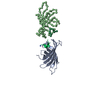
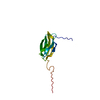

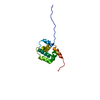

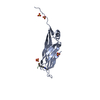
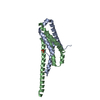

 PDBj
PDBj












